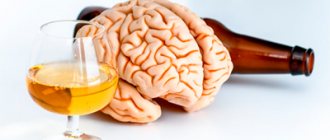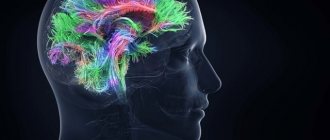Content:
- Main signs of chronic alcohol addiction
- Forms of abuse that precede addiction
- Symptoms of stage 1 alcoholism.
- Signs of stage 2 alcohol addiction.
- Symptoms of the 3rd (final) stage of alcoholism.
- Why alcoholics do not admit that they have an alcohol addiction
Alcohol addiction is a biosocial disease that requires full treatment under the supervision of narcologists. It is very difficult to get rid of it on your own. One of the reasons is that an alcoholic does not consider himself sick for a long time and does not want to be treated. Therefore, it is very important for loved ones to know the characteristic symptoms of alcoholism in order to notice the onset of its development in time and take the necessary measures.
Treatment of chronic alcoholism
According to statistics, most often people who are in the second stage of the disease seek treatment for chronic alcoholism. This can be explained quite simply: at the first stage, very few are ready to admit the fact of alcoholism, justifying their pathological addiction with stress, the need to relax and other reasons. At the third stage, the treatment of severe systemic diseases, such as renal and liver failure, malignant neoplasms, as well as mental disorders, comes to the fore. Therefore, at the final stage, the priority becomes preserving the patient’s life.
But at the second stage, even for the patient himself, the need for treatment may become obvious. Discord in the family, poor relationships with loved ones, job loss and other “external” factors signal that it is time to take action.
The treatment regimen for alcoholism is drawn up depending on a number of features of the situation (age, gender, health status of the patient, stage of alcoholism and signs that manifest the disease). The therapy process uses a complex of different methods, each of which is aimed at eliminating one or more aspects of alcoholism. Thus, in the treatment of addiction, medications, group and individual psychotherapeutic sessions, lifestyle correction, etc. are used.
Family alcoholism deserves special attention, as a result of which children, observing their parents’ libations from an early age, acquire the attitude that alcoholic drinks and an antisocial lifestyle are normal and natural. In such cases, treatment should be carried out for all family members suffering from alcoholism - this is the only way to eradicate the cause of the disease.
It should be noted the importance of psychotherapy in the treatment of alcoholism, since this disease develops with the participation of psychological dependence with subsequent psycho-emotional disorders. When working with a patient, a specialist conducts classes on developing motivation and maintaining it, explaining the consequences of chronic alcoholism for the health and life of the patient, and advises relatives and friends, on whose behavior the success of treatment also largely depends.
Main signs of chronic alcohol dependence
The disease occurs in three stages. Each of them has its own symptomatic
painting. Only a specialist can make a diagnosis, but almost any observant person can suspect the presence of a problem. To do this, he must understand what alcoholism actually is.
Alcoholism in narcology is generally considered to be alcohol abuse, manifested by mental cravings and physical dependence against the background of constant or periodic drunkenness. The process gradually progresses and becomes the cause of degradation. There is only one way to stop the development of addiction to drinking - a complete refusal to drink alcohol. Alcoholics will never be able to drink “culturally”, rarely and in small doses.
Second stage
The main difference between the 2nd stage of alcoholism and the first is the formation of not only mental, but also physical dependence, as well as the increase in other symptoms of the disease.
Physical dependence
is explained by the special effect of ethanol on the body with the formation of addiction, when organs and organ systems can no longer function normally without its constant supply.
Mental dependence continues to progress
– without a dose of alcohol, a person experiences significant discomfort, and only alcohol can restore him to a good mood and performance.
Severe mental and physical dependence leads to withdrawal syndrome
, or withdrawal syndrome, characterized by severe psychosomatic disorders during prolonged refusal (voluntary or forced) from alcohol. An alcoholic who no longer receives the vital dose of ethanol changes his mood. He experiences deep depression and outbursts of aggression, is depressed, and suffers from insomnia and nightmares. Somatic disorders are manifested by pain in the heart, tachycardia, headaches and muscle pain. Unlike a hangover, all these symptoms do not arise after abuse, but during a long absence of alcohol, but are also relieved by a dose of ethanol.
Tolerance continues to
to alcohol, but not indefinitely - with alcoholism of the 2nd degree, there comes a moment when the so-called plateau of tolerance occurs - it stops growing and remains at the same steady level with maximum doses of alcohol that do not cause intoxication.
At the 2nd stage of alcoholism, the disease can occur in a chronic or binge form. In the chronic course, the patient takes some doses of alcohol every day (not always to the point of extreme intoxication), and in the case of binge drinking, he drinks for several days (weeks and even months) in a row, getting drunk until he completely blacks out.
Loss of control and alcohol amnesia continue to progress - more and more often a person drinks not to the point of light intoxication and pleasant euphoria, but gets drunk “to the point of passing out” and then cannot remember significant periods of his life. When you binge drink, entire weeks and months can disappear from your memory - from the first drink you drink until you sober up.
Changing the nature of intoxication
– the euphoria and complacency inherent in everyday and beginning alcoholism are replaced by aggressiveness or attacks of melancholy.
Social maladjustment
– the patient begins to have problems in the family (quarrels, divorce), at work (absenteeism with subsequent reprimands and dismissal).
If treatment was not carried out at the 2nd stage of alcoholism, the disease moves into the next phase.
Forms of abuse that precede addiction
Drunkenness is any consumption of alcohol that negatively affects social and family life, work, and cultural level.
In narcology, the following types of pre-morbid alcoholization are distinguished:
Occasional intake of small quantities of intoxicating drinks containing ethanol: 1-2 times a month or less.- Systematic use. The drinker consumes wine and vodka products or beer 1-2 times a week or more often, trying to achieve noticeable euphoria.
- Heavy drunkenness. A person with this form of abuse already drinks to a pronounced degree of intoxication, often daily. He can get drunk both in his free time and at work.
But despite all the described phases of alcoholization, people who drink do not yet have an addiction. But when it manifests itself, it makes sense to think about the formation of the disease.
Causes of chronic alcoholism
Among the causative factors for the development of the disease, several of the most common ones can be identified:
- Personality features
. Inability to withstand stress, reduced adaptive abilities, communication problems, etc. often lead to the consumption of alcoholic beverages as one of the most accessible methods to “drown out” negative emotions. - Long stay in an appropriate environment
- social or cultural, in which regular alcohol consumption is considered the norm. - A lifestyle
associated with increased psycho-emotional stress, constant stress, overwork at work, etc.
A number of health conditions (thyrotoxicosis, neurotic conditions, etc.) can contribute to the development of addiction, as they reduce the body’s resistance to alcohol and at the same time facilitate the formation of this harmful habit.
Symptoms of stage 1 alcoholism
The onset of the disease is indicated by the appearance of a mental craving for alcohol. All thoughts and subconscious desires of the drinker are subordinated to the need to drink. At this stage, a novice alcoholic most often denies his addiction.
This phase is characterized by:
- Partial or complete loss of control over the amount of alcohol taken
products. - Primary pathological attraction that occurs before excess.
- An increase in the volume of alcohol consumed to achieve intoxication.
- Increasing frequency of alcoholism.
A person can temporarily resist the growing desire only if he does not have the opportunity to drink. But he does everything to implement it at the first opportunity. The duration of the initial period is on average 5 years.
First stage
The first stage of alcoholism is characterized by minimal severity of mental dependence, absence of physical dependence and blurred, hidden symptoms. The patient is socially adapted - he works or studies, is in a familiar environment, does not move away from his family and does not consider his passion for alcohol dangerous or harmful. Moreover, at this stage, relatives and close friends also refuse to recognize the person as an alcoholic, considering his desire to drink from time to time “for relaxation” or on a holiday to be completely acceptable and normal.
This attitude of family members towards the patient, the denial of already formed, albeit still just beginning, alcoholism, characterizes codependency - changes in the mental state and lifestyle of relatives of an alcoholic. The patient’s own perception of his condition is characterized by a lack of self-criticism and the ability to adequately evaluate himself and his actions, and non-recognition of the disease. He will never agree to consider himself an alcoholic and will find a lot of explanations and justifications for his addiction. Therefore, it is extremely important that at least relatives are able to notice the symptoms typical for the first stage of alcoholism, raise the alarm in time and consult a doctor.
Symptoms of the first stage include:
Increasing tolerance to alcohol
- a person is able to drink, without getting drunk, much more alcohol compared to other people or to his previous doses of alcohol.
At the same time, there is a suppression of protective reactions, in particular vomiting, with an overdose of ethanol. The body seems to get used to the constant supply of large doses of alcohol and ceases to perceive it as poison. However, the toxic effect of ethyl alcohol remains the same, which creates a high risk of acute alcohol poisoning in the first stages of alcoholism: a person drinks without getting drunk or gagging, huge doses of alcohol that can cause serious disturbances in the functioning of the brain, heart, liver and kidney
Decreased control over the amount of drinking
– an alcoholic drinks not just one or two glasses “for company” or to support a toast, he drinks the maximum amount of alcohol possible for himself. It is no longer enough for him to feel slightly intoxicated; more and more often he gets drunk to the point of “passing out” with memory loss.
At the initial stage of alcoholism, a hangover begins to occur - a set of characteristic symptoms that develop after acute alcohol intoxication. The next morning after drinking a large amount of alcohol, a number of unpleasant sensations arise - nausea, vomiting, trembling in the hands, headache. These symptoms are leveled out by taking the next dose of alcohol.
Alcohol blackouts
– another symptom that occurs at the 1st stage of alcoholism. Both individual episodes and long periods of time can fall out of memory.
Mental dependence
– its formation clearly separates even early alcoholism from everyday drunkenness. The patient clearly shows (especially when viewed from the outside) the presence of psychological discomfort, irritability, and mood swings during long periods without alcohol. And, on the contrary, when drinking alcohol or even when planning, waiting for the opportunity to drink, he becomes complacent and perks up.
Mental dependence, combined with increased tolerance and suppression of defensive reactions to alcohol, leads to an increase in the frequency of alcohol consumption
. An alcoholic experiences (sometimes unconsciously) melancholy without the usual dose, and the delayed development of intoxication and the absence of a gag reflex create a false sense of permissiveness, the ability to drink without harm even every day.
The beginning of a change in the value system
– the role of alcohol becomes more and more significant in the life of an alcoholic. He is no longer always able to refuse drinking on the eve of an important event (an exam, a test at work, a planned outing with the children, etc.), and if he refuses, he overpowers himself and experiences a feeling of dissatisfaction with life. Gradually, alcohol begins to crowd out all other values and priorities from the patient’s life.
If treatment is not started at this stage of the development of alcoholism, the disease will inevitably progress and move into the next phase.
Signs of stage 2 alcohol addiction
The full-blown form of the disease can be identified by new symptoms that complement existing ones.
These include:
- Adding to the loss of quantitative and situational control. The patient does not care where, how or with whom to drink.
- Adding to the mental craving a pronounced physical attraction. No drunkard can cope with it.
- The formation of withdrawal syndrome is one of the formidable symptoms of alcoholism. It is characterized by the need for a hangover to relieve the painful sensations of withdrawal. Hangover complaints include: feeling unwell, trembling and pain throughout the body, sweating, chills, fears, convulsions, thinking disorders, and aggressiveness. A small dose of ethanol eliminates all problems almost immediately.
- The need to drink a significant amount of alcohol (increasing tolerance), reaching several liters of strong drinks per day to obtain the required pronounced intoxication.
- Manifestation of increasing signs of degradation. The drunkard at this stage begins to “descend” from external untidiness to the formation of mental inferiority.
During the advanced phase of the disease, which lasts an average of 10-12 years, binges appear - drinking large quantities of alcohol for many days. Between excesses, “light” intervals are determined, during which a person does not drink at all and assures everyone that he is healthy. Often, after the end of the drinking period, acute psychosis (delirium tremens) develops on days 2-3.
Consequences of alcoholism
As a result of chronic alcohol intoxication, the patient experiences irreversible changes in the body. Since the liver takes the brunt of alcohol, hepatocytes gradually die and are replaced by connective tissue (fibrosis). The stomach and intestines also suffer. The cardiovascular system is also affected: patients have a sharply increased risk of heart attack or stroke.
Damage to the nervous system manifests itself in:
- asthenic syndrome, the symptoms of which are nervousness, sudden mood swings);
- hallucinations;
- alcoholic delirium;
- decreased mood (dysphoria);
- moral degradation of the individual;
- disturbances of consciousness.
The consequences of uncontrolled alcohol consumption go much further than the patient himself.
Alcoholism also means an increase in crime, since most offenses are committed while drunk, and an increase in the number of fatal accidents. Because of alcohol, the number of divorces is increasing and children are suffering. Alcoholism leads to enormous material and economic damage to the state.
Alcoholism is a progressive chronic disease in which uncontrolled consumption of alcoholic beverages occurs in combination with physical and mental dependence on ethanol. The whole process goes through 4 successive stages, the border between them is very thin and sometimes imperceptible to the patient himself. If alcohol addiction is not treated, irreversible processes quickly develop and increase in the body, ultimately leading to death.
Symptoms of the 3rd (final) stage of alcoholism
The manifestation of the final phase is characterized by qualitatively different symptoms.
Signs of alcohol dependence at this stage:
- The attraction to drinking becomes uncontrollable and is caused not by the desire for euphoria, but
the desire to relieve depression and other psychophysical discomfort. - Decreased tolerance. People begin to get drunk from small doses and often drink weak drinks.
- Formation of an abstinence variant that requires constant hangover several times during the day, including at night.
- The development of pronounced personality degradation is the most striking symptom of late-stage alcoholism. Alcoholics lead a vagabond lifestyle, lose their family, their jobs, beg, and humiliate themselves in order to get a drink. They have many chronic pathologies: cardiopathy, geaptitis and cirrhosis, encephalopathy and neuropathy.
- Diagnosis of alcoholic psychoses. Externally, they manifest themselves with a variety of neurological symptoms. Patients talk to themselves, live in the grip of hallucinations, do not recognize anyone, are disoriented in space and time, and lose cognitive abilities and memory.
A minority of patients survive to stage 3. Death from severe complications most often occurs at the end of the phase of full-blown alcoholism.
The effect of alcohol on the human body
Alcohol from the stomach enters the bloodstream two minutes after consumption. The blood carries it to all cells of the body. The cells of the cerebral hemispheres are primarily affected. The conditioned reflex activity of a person worsens, the formation of complex movements slows down, and the ratio of excitation and inhibition processes in the central nervous system changes. Under the influence of alcohol, voluntary movements are impaired, and a person loses the ability to control himself.
The effect of alcohol on the nervous system
Signs of alcohol dependence begin to form due to the peculiarities of its effect on the nervous system. The penetration of alcohol into the cells of the frontal lobe of the cortex liberates a person’s emotions, unjustified joy, stupid laughter, and ease of judgment appear. Following increasing excitation in the cerebral cortex, a sharp weakening of inhibition processes occurs. The cortex ceases to control the work of the lower parts of the brain. A person loses restraint, modesty, he says and does things that he would never say or do if he were sober. Each new portion of alcohol increasingly paralyzes the higher nerve centers, as if connecting them and not allowing them to interfere with the activity of the lower parts of the brain: coordination of movements is disrupted, for example, eye movement (objects begin to double), and an awkward, staggering gait appears. Disruption of the nervous system and internal organs is observed with any alcohol consumption: one-time, episodic and systematic. It is known that disorders of the nervous system are directly related to the concentration of alcohol in a person’s blood. When the amount of alcohol is 0.04-0.05 percent, the cerebral cortex turns off, a person loses control over himself, and loses the ability to reason rationally. At a blood alcohol concentration of 0.1 percent, the deeper parts of the brain that control movement are inhibited. A person’s movements become uncertain and are accompanied by causeless joy, animation, and fussiness. However, in 15 percent of people, alcohol can cause depression and a desire to fall asleep.
As the alcohol content in the blood increases, a person’s ability to hear and visual perception is weakened, and the speed of motor reactions is dulled. An alcohol concentration of 0.2 percent affects areas of the brain that control emotional behavior. At the same time, base instincts awaken and sudden aggressiveness appears. With a blood alcohol concentration of 0.3 percent, a person, although conscious, does not understand what he sees and hears. This condition is called alcoholic stupor. A blood alcohol concentration of 0.4 percent causes loss of consciousness. The person falls asleep, his breathing becomes uneven, and involuntary emptying of the bladder occurs. There is no sensitivity. At a blood alcohol concentration of 0.6-0.7 percent, death can occur. As a result of episodic drinking of alcohol, a painful addiction and uncontrollable craving for alcohol often develops - alcoholism.
Why don't drunkards admit that they have alcohol addiction?
During a conversation with most drinkers, the fact becomes clear that they do not want to see and accept their illness.
This phenomenon is due to several reasons:
- Reluctance to be treated.
- The presence of a craving for alcohol, dominating all needs.
- Degradation – loss of motivation and desire for a sober and healthy life.
Signs of alcohol addiction are very varied. In practice, there are atypical forms that manifest themselves as diverse complaints and symptoms.
Need some advice?
OR CALL A DOCTOR
CALL!
+7
Can alcoholism be cured?
Yes and no. No - in the aspect that it will never be possible to resume “cultural drinking”. The metabolic processes of the brain are disrupted, and the normal reaction to alcohol will never be restored. Any consumption of alcohol will inevitably lead to a breakdown, immediately or some time later. If metabolic disturbances occur, consider that your barrel or tank is drunk. Even many years of abstinence do not allow you to count on the fact that “the body has been cleansed” and you will be able to drink culturally.
Yes - in the sense that even with severe alcoholism, complete and indefinitely long abstinence from alcohol is possible. A person is not only a physical body. And his psyche does not consist only of what the disease brought, but contains untapped resources. Man is characterized by higher moral feelings - love, the desire for beauty and harmony. Having done long and difficult work on oneself (with help, of course), developing psychologically and spiritually, a person is able to change his attitude towards alcohol and give it up forever. But, of course, we can only talk about absolute sobriety. To drink or not to drink—alcoholism leaves no third option. With their own unwavering determination with medical help, even very seriously ill patients can achieve amazing results.
What to do if the patient does not agree to be treated?
If there are signs of alcohol dependence, it is imperative to make constant attempts to convince the patient of the need for therapy. It requires the combined efforts of all interested and significant people for the patient (relatives, friends, spouses, employees, teachers, etc.). There is a specially developed method of encouraging an alcoholic to seek help, which is called an “intervention.” Each of the participants in the intervention (parents, spouse, child, boss) tries to help the patient realize the presence of a problem by reporting the changes in him and the changes in their lives that are caused by alcohol consumption. When the desired result is achieved, they offer a solution - treatment in a specific medical institution, a rehabilitation program. This method often requires the participation of a psychotherapist to coordinate and dose the efforts of the actors.
Is it possible to treat a patient without his consent?
In Russia, assistance to patients with alcoholism is regulated by the Law of the Russian Federation “On psychiatric care to the population and the rights of citizens in its provision.” According to the law, treatment of a patient with drug addiction, substance abuse or alcoholism is carried out on the basis of his voluntary consent. Treatment without the patient’s consent is carried out only by court order when the citizen is brought to criminal liability.
As mentioned earlier, alcoholism is a disease, and like any disease it requires thorough and long-term treatment. Appeals to dubious “specialists” who treat alcoholism “by photograph”, “without the knowledge of the patient”, firstly, is a waste of time, and secondly, it instills in the patient a belief in the incurability of this disease.











